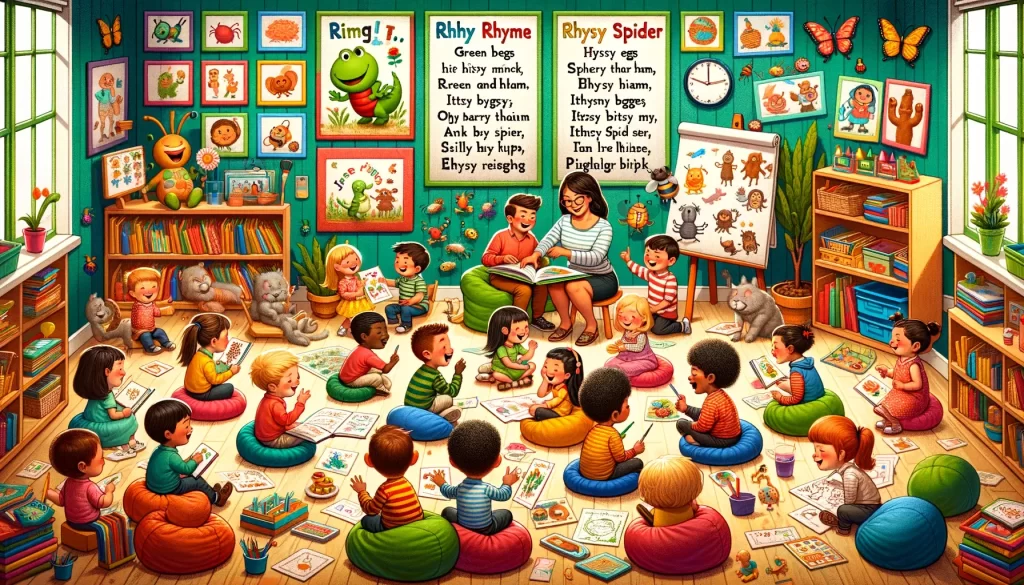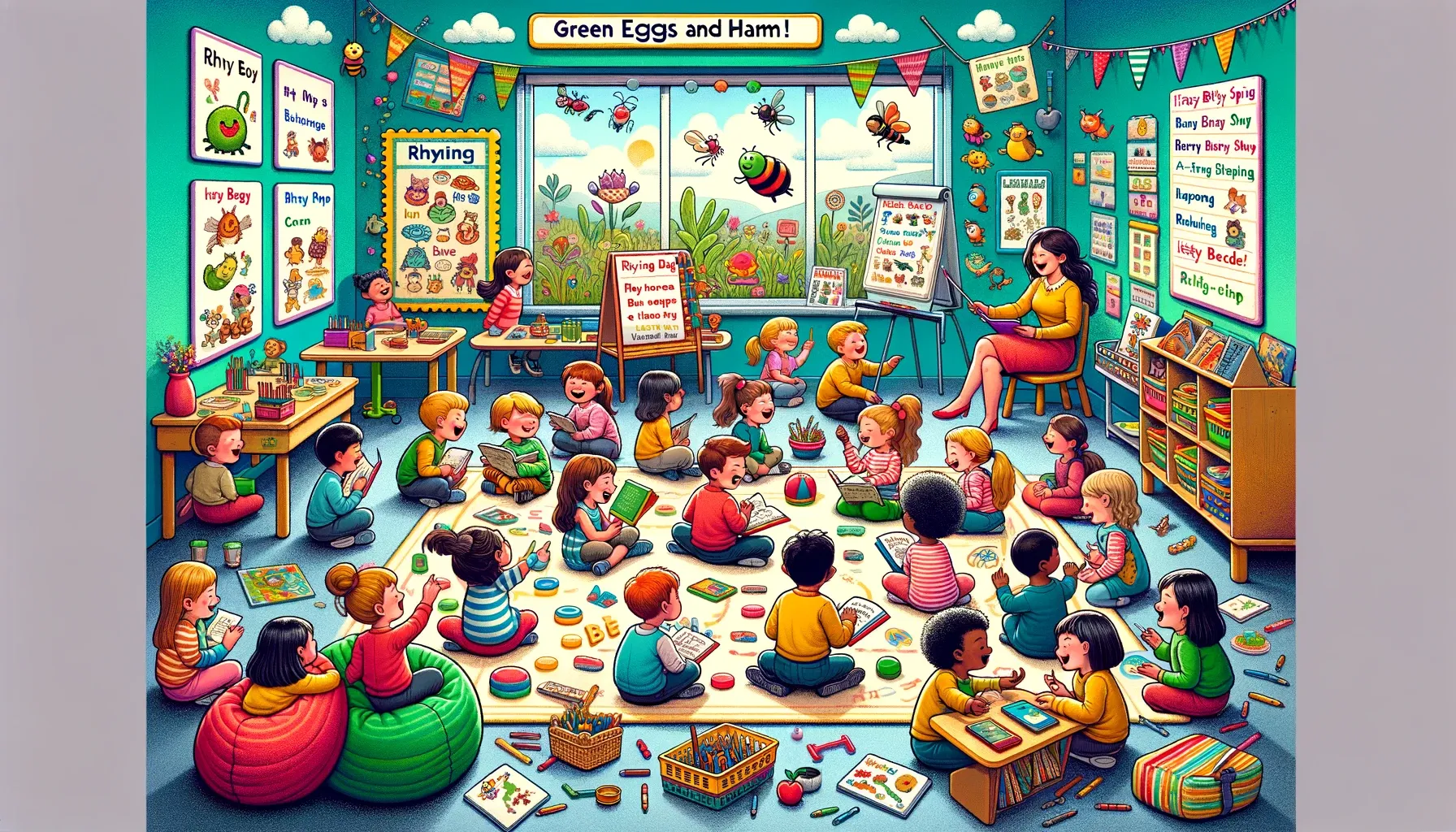Use rhyme-without-reason activities to teach literacy skills in preschool and elementary classrooms. This post shares 200 Rhyme Without Reason Ideas for games, books, songs, crafts, and more using rhyming.
Rhyming helps kids learn literacy skills and makes lessons more engaging and fun. That’s why rhyme-without-reason activities are great for preschool, kindergarten, and early elementary classrooms. Here are 200 Rhyme Without Reason Ideas you can use in your school!
Why Use Rhyme Without Reason Ideas in the Classroom?

Rhyming helps develop phonological awareness – the ability to identify and manipulate sounds in language. This skill is vital for learning to read. Other benefits of rhyming include:
- Improves vocabulary and oral language skills
- It helps memorization of facts and routines
- Provides opportunities for creative expression
- It makes lessons more enjoyable and interactive
Rhyming Books for Circle Time
Reading rhyming books aloud is an easy way to incorporate rhyme into your day. Try these classic titles:
- Dr. Seuss’s books like Green Eggs and Ham, The Cat in the Hat, and One Fish, Two Fish, Red Fish, Blue Fish
- Sandra Boynton’s books such as Barnyard Dance and Blue Hat, Green Hat
- Classic nursery rhyme collections
- Rhyming poetry books by poets like Jack Prelutsky
Have kids join in rhyming refrains. Point out rhyming words. Ask children to generate silly rhyming phrases.
Rhyming Fingerplays, Chants and Songs
Fingerplays, chants, and rhyming songs help kids develop literacy skills in a fun, active way. Try these ideas:
- Nursery rhyme fingerplays like “Itsy Bitsy Spider” and “Twinkle Twinkle Little Star.”
- Rhyming chants like “Banana Fana Fo Fana.”
- Silly rhyming songs like “Down By the Bay.”
- Echo songs where you sing a line, and kids repeat
- Makeup rhymes using kids’ names
Encourage movement, gestures, and active participation. Let kids lead rhymes too. Record videos to share with parents.
Read also: Japanese Kanji for Strength
Rhyming During Transitions
Use rhyming chants, poems, and songs during transition times. This keeps kids focused and engaged:
- Line-up rhymes: “Line up short, line up tall, line up big, line up small”
- Clean up rhymes: “Clean up, clean up, pick up all your toys. Put them neatly away, so we don’t make a noise!”
- Rhyming riddles for guessing the next activity
- Echo rhymes to get attention like “Clap, clap, clap your hands! (Clap, clap, clap your hands!)”
Come up with creative rhymes for your classroom routines. Let kids invent their rhymes too.
Rhyme Without Reason Art Projects
Incorporate rhyming into art, crafts, and writing projects:
- Draw silly rhyming creatures like a cat in a hat
- Makeup rhymes about sculptures kids create from playdough or clay
- Put together rhyming recipe books like “Tickle My Pickle Banana Bread”
- Write acrostic rhyming poems using kids’ names
- Illustrate classic nursery rhymes
- Create rhyming books as a class
Display these rhyming creations in your classroom or hallway. Send home to families.
Rhyming Games
Play rhyming games to build phonological skills:
- Rhyming bingo
- Rhyming word memory match
- I Spy rhymes: “I spy with my little eye something that rhymes with hill”
- Rhyme draw: Take turns drawing and rhyming
- Rhyming charades
- Finish the rhyme: “Cat, hat, bat, ____”
- Rhyming word pairs like “cat-bat”
- Odd one out Which word doesn’t rhyme?
Keep a rhyming word box or jar kids can pull from when playing games.
Rhyming as Brain Breaks
Take rhyming brain breaks to refresh and refocus kids:
- Give students a category like animals. See who can come up with the most rhymes.
- Do rhyme chains where each person says a word that rhymes with the previous.
- Give kids a sentence prompt like “The dog sat on a…” and have them fill in a rhyme.
- Play rhyming riddle games like “What do you call a happy monkey? A funky monkey!”
- Jump, clap, or stomp for rhyming word pairs.
- Tell silly rhyming riddles or jokes.
Keep brain breaks short, active, and fun. Give shy kids easy rhymes to start with.
Rhyming for Classroom Rules and Routines
Incorporate rhymes into your everyday classroom procedures:
- Set up a rhyming daily schedule poster
- Create rhymes for cleanup like “Clean it up, put it away, let’s make our room clutter-free today!”
- Rhyme transitions like “Feet on the floor, mouths are closed, hands in lap, eyes on me – let’s get ready for storytime!”
- Make a rhyming classroom promise chart
- Give rhyming praise like “You picked up all your toys, hmm boy, hmm boy!”
- Post a rhyming classroom rules poster
Rhymes help reinforce routines in a fun, memorable way. Let kids create their rhymes too.
Themed Rhyming Activities
Match rhymes to curriculum themes:
- Ocean rhymes for an under-the-sea unit
- Dinosaur stomps and rhymes for dinosaurs
- Weather rhymes for a weather unit
- Space and rocket rhymes for space
- Spooky Halloween rhymes
- Holiday and seasonal rhymes
Use rhymes to introduce and reinforce new vocabulary and concepts. Display rhymes in learning centers.
Rhyming on learning walks
Use rhymes during learning walks and transitions:
- Makeup rhymes about things you see
- Challenge kids to find things that rhyme as they walk
- Chant rhyming words as footsteps
- Skip or march to rhythms as you move
- Sing rhyming songs together as you walk
Outdoor rhymes combine learning with physical activity and time in nature.
Nursery Rhyme-themed Activities
Do themed activities based on favorite nursery rhymes:
- Act out “Humpty Dumpty” with egg painting and crafts
- Cook porridge and have a “Goldilocks” dramatic play area
- Make paper bag “Little Pigs” houses and do big bad wolf crafts
- Put out plastic spiders and “Itsy Bitsy Spider” props
- Set up “Jack Be Nimble” candlestick jumping
- Read nursery rhymes then ask comprehension questions
Capitalize on kids’ love of nursery rhymes. Encourage creative extensions.
Rhymes for Calming and Mindfulness
Incorporate rhyme into calming and mindfulness exercises:
- Do a “fingerplay massage” with calm breathing and rhymes
- Recite peaceful rhyming poems during meditation
- Sing soothing lullaby rhymes
- Chime fingering along with rhymes promotes focus
- Have kids visualize scenes that match soothing rhymes
- Whisper rhyme refrains together as a quiet activity
Rhymes enhance relaxation, focus, and self-regulation skills.
Supporting Early Literacy with Rhyme
Rhyming engages kids while building essential early literacy skills. With so many possibilities for integrating rhyme into your school day, there are endless opportunities to teach creatively while setting students up for reading success.
Try out some of these rhyme-without-reason ideas in your classroom. Discover how rhyming enhances learning and makes lessons unforgettable. Your students will love learning with rhymes!
Final Words- Rhyme Without Reason Ideas
Rhyming is a powerful teaching tool that makes lessons engaging while developing vital early literacy skills. With this list of 200 Rhyme Without Reason Ideas, you’ll have plenty of inspiration to integrate rhyming into your preschool or elementary classroom. Use rhymes across your daily schedule, curriculums, and activities to reinforce routines, enhance focus, and bring joy to learning. Tap into the educational magic of rhyme and watch your students thrive!

